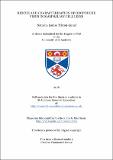Files in this item
Rescue and characterisation of Oropouche virus in mammalian cell lines
Item metadata
| dc.contributor.advisor | Elliott, Richard M | |
| dc.contributor.advisor | Randall, Richard E | |
| dc.contributor.author | Tilston-Lunel, Natasha Louise | |
| dc.coverage.spatial | 317 p. | en_US |
| dc.date.accessioned | 2018-02-21T11:36:17Z | |
| dc.date.available | 2018-02-21T11:36:17Z | |
| dc.date.issued | 2016 | |
| dc.identifier.uri | https://hdl.handle.net/10023/12769 | |
| dc.description.abstract | Oropouche virus (OROV) is a medically important orthobunyavirus, which causes frequent outbreaks of a febrile illness in the northern parts of Brazil. However, despite being the cause of an estimated half a million human infections since its first isolation in Trinidad in 1955, details of the molecular biology of this tripartite, negative-sense RNA virus remain limited. The work presented in this thesis has re-determined the nucleotide sequences of OROV strain BeAn19991 (GenBank accession numbers: L, KP052850; M, KP052851 and S, KP052852), and demonstrates that the S segment is significantly longer than the published sequence with an additional 204 nucleotides at the 3' end. Data analysis revealed that there is a critical nucleotide mismatch at position 9 within the base-paired terminal panhandle structure of each genomic segment. Using a combination of deep sequencing and Sanger sequencing the complete genome sequences of 10 field isolates of OROV were also determined for the first time, and led to the identification of a novel OROV reassortant virus. Phylogenetic analysis of these sequences and of published sequences showed that there are two genotypes of OROV, rather than the four genotypes previously proposed. Further work led to the development of a T7-RNA polymerase-driven minigenome and virus-like particle (VLP) production systems for OROV; the information from these was subsequently used to develop a reverse genetics system for OROV. Using reverse genetics, OROV mutants that lack either the non-structural proteins NSm or NSs were generated. In vitro growth properties of the OROV mutant lacking NSm were indistinguishable from the wild-type virus, but the NSs mutant was attenuated in growth, particularly in interferon (IFN) competent cells. Further work demonstrated NSs as a viral IFN antagonist and that it’s C-terminus is required for this activity. Interestingly, OROV is more resistant to IFN-α treatment than Bunyamwera virus, but this is not related to its NSs protein. The development of a reverse genetics system for OROV, which is the main human pathogen within the Simbu serogroup of orthobunyaviruses, will prove invaluable for future studies designed to further investigate the molecular pathogenesis of this virus and in the development of attenuated vaccine strains. | en_US |
| dc.language.iso | en | en_US |
| dc.publisher | University of St Andrews | |
| dc.rights | Attribution-NonCommercial-NoDerivatives 4.0 International | * |
| dc.rights.uri | http://creativecommons.org/licenses/by-nc-nd/4.0/ | * |
| dc.subject | Oropouche virus | en_US |
| dc.subject | Orthobunyavirus | en_US |
| dc.subject | Bunyavirus | en_US |
| dc.subject | Oropouche virus phylogeny | en_US |
| dc.subject | Reverse genetics | en_US |
| dc.subject.lcc | QR398.7T5 | |
| dc.subject.lcsh | Bunyaviruses | en |
| dc.subject.lcsh | Reverse genetics | en |
| dc.title | Rescue and characterisation of Oropouche virus in mammalian cell lines | en_US |
| dc.type | Thesis | en_US |
| dc.contributor.sponsor | Medical Research Council (MRC) | en_US |
| dc.type.qualificationlevel | Doctoral | en_US |
| dc.type.qualificationname | PhD Doctor of Philosophy | en_US |
| dc.publisher.institution | The University of St Andrews | en_US |
| dc.rights.embargodate | 2018-03-02 | |
| dc.rights.embargoreason | Thesis restricted in accordance with University regulations. Print and electronic copy restricted until 2nd March 2018 | en |
The following licence files are associated with this item:
This item appears in the following Collection(s)
Except where otherwise noted within the work, this item's licence for re-use is described as Attribution-NonCommercial-NoDerivatives 4.0 International
Items in the St Andrews Research Repository are protected by copyright, with all rights reserved, unless otherwise indicated.


